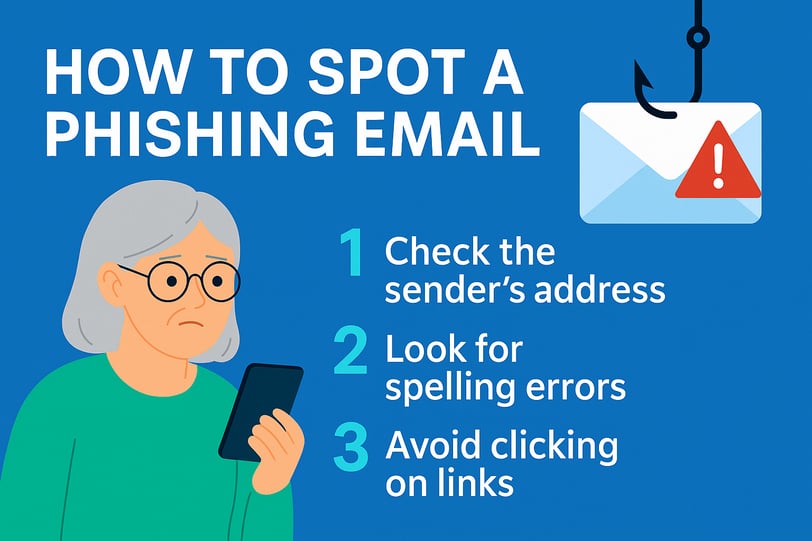How to Spot a Phishing Email in 2025 – Tips for Seniors


How to Spot a Phishing Email – Easy Tips for Seniors
📅 Published: July 10, 2025 | Category: Cyber Awareness
📘 Introduction
Phishing scams are on the rise in Australia, especially among seniors who may not be familiar with the latest digital tricks. Learn how to identify fake emails from ATO, MyGov, and more — before it’s too late.🔍 What is a Phishing Email?
A phishing email is a fake message that looks real. It tries to trick you into clicking on a link, downloading an attachment, or giving away personal information — such as your passwords, Medicare number, or bank details.
📌 Common Signs of a Phishing Email
1️⃣ Strange or Suspicious Email Address
It might say “support@anz-securemail.com” — but if you hover over it, you’ll see it’s not from the real ANZ domain.
💡 Tip: Always double-check the sender’s email address before opening or replying.
2️⃣ Urgent or Threatening Language
Messages like “Your account will be locked in 24 hours” or “Immediate action required” are common scare tactics.
💡 Tip: Don’t panic. Real organisations won’t pressure you like this via email.
3️⃣ Links to Fake Websites
Emails may ask you to “verify your identity” or “log in” via a link. These pages often look exactly like real banking or government sites.
💡 Tip: Don’t click links. Visit the official website by typing the address directly.
4️⃣ Unexpected Attachments
You receive a file labeled “Invoice” or “Statement” — even though you never requested it.
💡 Tip: Never download attachments unless you're sure it’s safe.
5️⃣ Poor Spelling or Grammar
Scammers often use awkward phrasing, incorrect punctuation, or unusual greetings like “Dear Customer.”
💡 Tip: Legitimate companies usually proofread emails — bad grammar is a red flag.
6️⃣ Too Good to Be True Offers
“Congratulations! You’ve won a $500 gift card” or “Free trial just for you” — if it sounds too good to be true, it is.
💡 Tip: Never click on suspicious promotions or prize links.
🛡️ How to Stay Safe
✅ Use strong, unique passwords for all your accounts.
✅ Enable two-factor authentication (2FA) where possible.
✅ Install reliable antivirus software and keep it updated.
✅ Never share personal information via email.
✅ If in doubt, call the company directly using the number on their official website.
🧓 A Special Note for Seniors
Many phishing scams specifically target older Australians. If you receive a suspicious email:
Don’t reply, click links, or download attachments.
Ask a trusted family member or friend for help.
Report it to Scamwatch.gov.au.
“A strong password is your first defense—must read common password mistakes.
✅ Final Thoughts
Phishing emails are becoming harder to detect — but staying alert is your best defence. By learning the warning signs and sharing this knowledge with your loved ones, you're helping build a safer online community. “See real scam email examples from Australia Post and more.”
If you're unsure about any email, don’t act in a rush. Pause, verify, and stay protected.
Stay smart. Stay safe. Be a CyberHero.
📬 Follow CyberShield Academy for weekly tips and cyber safety guides.
Safety
Empowering families to navigate online risks securely.
Guidance
Community
cyberhero.support@example.com
1800-555-0199
© 2025. All rights reserved.